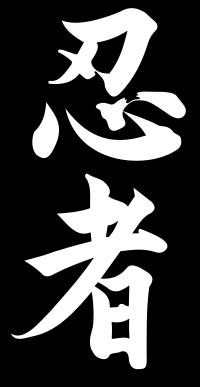Ninjutsu
Ninjutsu (忍術), sometimes used interchangeably with the modern term ninpō (忍法),[1] is the strategy and tactics of unconventional warfare, guerrilla warfare and espionage purportedly practiced by the ninja.[2] Ninjutsu was a separate discipline in some traditional Japanese schools, which integrated study of more conventional martial arts (taijutsu) along with shurikenjutsu, kenjutsu, sōjutsu, bōjutsu and others.
 | |
| Also known as | Ninpō, Shinobi-jutsu |
|---|---|
| Hardness | Non-competitive |
| Country of origin | |
| Parenthood | Military tactics |
While there is an international martial arts organization representing several modern styles of ninjutsu, the historical lineage of these styles is disputed. Some schools claim to be the only legitimate heir of the art, but ninjutsu is not centralized like modernized martial arts such as judo or karate. Iga Ryu claims to be the oldest recorded form of ninjutsu, and claims to have survived past the 16th century.
History
Spying in Japan dates as far back as Prince Shōtoku (572–622). According to Shōninki, the first open usage of ninjutsu during a military campaign was in the Genpei War, when Minamoto no Kuro Yoshitsune chose warriors to serve as shinobi during a battle. This manuscript goes on to say that during the Kenmu era, Kusunoki Masashige frequently used ninjutsu. According to footnotes in this manuscript, the Genpei War lasted from 1180 to 1185, and the Kenmu Restoration occurred between 1333 and 1336.[3] Ninjutsu was developed by the samurai of the Nanboku-cho period, and further refined by groups of samurai mainly from Kōka and the Iga Province of Japan in later periods.
Throughout history, the shinobi were assassins, scouts, and spies who were hired mostly by territorial lords known as daimyō. Despite being able to assassinate in stealth, the primary role was as spies and scouts. Shinobi are mainly noted for their use of stealth, and deception. They would use this to avoid direct confrontation if possible, which enabled them to escape large groups of opposition.
Many different schools (ryū) have taught their unique versions of ninjutsu. An example of these is the Togakure-ryū, which claims to have been developed after a defeated samurai warrior called Daisuke Togakure escaped to the region of Iga. He later came in contact with the warrior-monk Kain Doshi, who taught him a new way of viewing life and the means of survival (ninjutsu).[2]:18–21
Ninjutsu was developed as a collection of fundamental survivalist techniques in the warring state of feudal Japan. The ninja used their art to ensure their survival in a time of violent political turmoil. Ninjutsu included methods of gathering information and techniques of non-detection, avoidance, and misdirection. Ninjutsu involved training in freerunning, disguise, escape, concealment, archery, and medicine. Skills relating to espionage and assassination were highly useful to warring factions in feudal Japan. At some point, the skills of espionage became known collectively as ninjutsu, and the people who specialized in these tasks were called shinobi no mono.
See also
- Kunoichi
- Ninja in popular culture
References
- Green, Thomas A.; Svinth, Joseph R. (2011). Martial Arts of the World: An Encyclopedia of History and Innovation: An Encyclopedia of History and Innovation. Santa Barbara, California: ABC-CLIO. p. 163. ISBN 9781598842449. Retrieved 5 January 2016.
- Hayes, Stephen K. (1990). The Ninja and Their Secret Fighting Art (17th ed.). Rutland, Vermont: Tuttle. ISBN 0804816565.
- Masazumi, Natori; Mazuer, Axel; Graham, Jon E. (2010). Shoninki: The Secret Teachings of the Ninja: The 17th-Century Manual on the Art of Concealment (1st ed.). Rochester, Vernmont: Destiny Books. ISBN 9781594776670.
Further reading
- Bertrand, John (2006). "Techniques that made ninjas feared in 15th-century Japan still set the standard for covert ops". Military History. 23 (1): 12–19.
- Borda, Remiguisz. The Illustrated Ninja Handbook: Hidden Techniques of Ninjutsu. Tokyo–Rutland, Vt.–Singapore: Tuttle, 2014.
- Callos, Tom. "Notable American Martial Artists", Black Belt Magazine, May 2007, pp. 72–73.
- DiMarzio, Daniel. A Story of Life, Fate, and Finding the Lost Art of Koka Ninjutsu in Japan, 2008. ISBN 978-1-4357-1208-9
- Green, T. A. and J. R. Svinth. Martial Arts of the World: An Encyclopedia of History and Innovation. Santa Barbara, Calif.: ABC-CLIO, 2010.
- Hatsumi, Masaaki. Ninjutsu: History and Tradition, 1981. ISBN 0-86568-027-2
- Hatsumi, Masaaki. Ninpo: Wisdom for Life, 1998. ISBN 1-58776-206-4, ISBN 0-9727738-0-0
- Hayes, Stephen K. and Masaaki Hatsumi. Secrets from the Ninja Grandmaster, rev. ed. Boulder, Colo.: Paladin Press, 2003.
- Hatsumi, Masaaki. Essence of Ninjutsu, 1988. ISBN 0-8092-4724-0
- Mol, Serge (2008). Invisible Armor: An Introduction to the Esoteric Dimension of Japan’s Classical Warrior Arts. Belgium: Eibusha. ISBN 978-90-8133610-9.
- Mol, Serge (2016). Takeda Shinobi Hiden: Unveiling Takeda Shingen's Secret Ninja Legacy. Eibusha. pp. 1–192. ISBN 978-90-813361-3-0.
- Toshitora, Yamashiro. Secret Guide to Making Ninja Weapons, Butokukai Press, 1986. ISBN 978-99942-913-1-1
- Zoughari, Kacem. The Ninja: Ancient Shadow Warriors of Japan, Tuttle Publishing, 2010. ISBN 0-8048-3927-1
External links
| Wikimedia Commons has media related to Ninjutsu. |
- Ninjutsu techniques – ninjutsu kata and techniques in the AKBAN wiki
- Ninjutsu history – history of Ninjutsu and its evolution